Size of Problem Activities Smell a Flower Clip Art
Summary
By watching and performing several uncomplicated experiments, students develop an agreement of the properties of air: it has mass, it takes upwardly space, it can move, information technology exerts pressure, it tin practice piece of work.This engineering curriculum aligns to Adjacent Generation Science Standards (NGSS).
Engineering Connection
Engineers must sympathize the physical properties of air then they can determine the best way to remove pollutants from contaminated air. They written report how speedily air moves and how much pressure level it exerts. This knowledge helps them pattern filtration systems that efficiently move air through a organisation, while at the aforementioned time ensuring that pollutants are removed earlier the air is released into the atmosphere.
Learning Objectives
After this activity, students should be able to:
- Understand and explain that air takes upwardly space has mass, can movement, exerts force per unit area, and can practise work.
- Requite examples that demonstrate an understanding of the properties of air.
- Explicate why it is important for engineers to understand the properties of air.
Educational Standards Each TeachEngineering lesson or action is correlated to ane or more K-12 scientific discipline, technology, engineering or math (Stalk) educational standards.
All 100,000+ K-12 STEM standards covered in TeachEngineering are nerveless, maintained and packaged past the Achievement Standards Network (ASN), a project of D2L (world wide web.achievementstandards.org).
In the ASN, standards are hierarchically structured: first by source; due east.g., by state; within source by blazon; due east.thousand., science or mathematics; inside type by subtype, then by grade, etc.
Each TeachEngineering lesson or action is correlated to ane or more K-12 scientific discipline, technology, engineering or math (Stalk) educational standards.
All 100,000+ K-12 STEM standards covered in TeachEngineering are nerveless, maintained and packaged past the Achievement Standards Network (ASN), a project of D2L (world wide web.achievementstandards.org).
In the ASN, standards are hierarchically structured: first by source; due east.g., by state; within source by blazon; due east.thousand., science or mathematics; inside type by subtype, then by grade, etc.
NGSS: Next Generation Science Standards - Science
| NGSS Performance Expectation | ||
|---|---|---|
| 5-PS1-1. Develop a model to draw that matter is made of particles besides pocket-size to be seen. (Class 5) Do you agree with this alignment? Thank you for your feedback! | ||
| Click to view other curriculum aligned to this Operation Expectation | ||
| This activeness focuses on the post-obit Three Dimensional Learning aspects of NGSS: | ||
| Scientific discipline & Engineering Practices | Disciplinary Core Ideas | Crosscutting Concepts |
| Develop a model to describe phenomena. Alignment agreement: Thanks for your feedback! | Matter of whatsoever blazon can exist subdivided into particles that are as well minor to see, only even then the thing yet exists and tin exist detected by other ways. A model showing that gases are made from matter particles that are also small to see and are moving freely around in infinite can explain many observations, including the inflation and shape of a balloon and the effects of air on larger particles or objects. Alignment understanding: Thanks for your feedback! | Natural objects be from the very small-scale to the immensely big. Alignment agreement: Thanks for your feedback! |
International Technology and Engineering science Educators Association - Technology
- Explicate how knowledge gained from other content areas affects the development of technological products and systems. (Grades six - 8) More than Details
View aligned curriculum
Exercise you concur with this alignment? Thank you for your feedback!
Country Standards
Advise an alignment not listed to a higher placeSubscribe
Get the inside scoop on all things TeachEngineering such as new site features, curriculum updates, video releases, and more by signing upwards for our newsletter!
PS: We do not share personal information or emails with anyone.
Materials List
Each student needs a copy of the Air - Is Information technology Actually In that location? Worksheet
Demo 1 – Air Takes Upwardly Infinite
- Part A: 1 paper lunch pocketbook
- Part B: 1 airship, and i empty one-liter plastic pop or juice canteen (it must have a narrow cervix; remove the label)
Demo 2 – Air Has Mass
- 2 identical balloons
- ane meter stick
- 1 straight pin
Demo three – Air Can Motility (Nosotros Can Feel Information technology)
- 1 electric fan (table or floor size)
Demo 4 – Air Exerts Force per unit area (Information technology Pushes on Things)
- Part A - Pupil Activity: ane sheet of eight.v" x 11" paper per student
- Part B - Student Action: Each student needs 1 straw and 1 minor cup containing water
- Office C: ane medium sized jar with an opening smaller than an index carte du jour, 1 index card or piece of calorie-free-weight cardboard, 1 big bowl/dish in instance of spills, paper towels or rags in case of spills
- Function D: i small juice glass, 1 tissue and 1 medium basin filled with water
Demo 5 – Air Does Work
- one medium-sized plastic bag
- A stack of textbooks
Worksheets and Attachments
Visit [world wide web.teachengineering.org/activities/view/cub_air_lesson01_activity2] to impress or download.More Curriculum Like This
Upper Uncomplicated Lesson 
What'southward Air Got to Do with It? Properties & Quality
Students are introduced to the concepts of air pollution, air quality, and climate change. The three lesson parts (including the associated activities) focus on the prerequisites for agreement air pollution. First, students use Thousand&M® candies to create pie graphs that limited their understanding o...

Upper Elementary Lesson 
Got Dirty Air?
Students are introduced to the concepts of air pollution and technologies that engineers accept adult to reduce air pollution. They develop an understanding of visible air pollutants with an incomplete combustion demonstration, a "smog in a jar" sit-in, construction of simple particulate ma...

Middle School Lesson 
Carbon Cycles
Students are introduced to the concept of free energy cycles by learning near the carbon wheel. They learn how carbon atoms travel through the geological (ancient) carbon cycle and the biological/concrete carbon bike.

Middle School Lesson 
Get Me Off This Planet
The purpose of this lesson is to teach students how a spacecraft gets from the surface of the Earth to Mars. Students start investigate rockets and how they are able to get us into space. Finally, the nature of an orbit is discussed besides equally how orbits enable us to get from planet to planet — spec...

Introduction/Motivation
Most of the time, we hardly notice the air around us. We cannot usually see it or taste it. Air does not ordinarily aroma (but it does carry substances that nosotros do scent). Yet, you can feel air when it moves and you can come across the effects of air on your surround. When air moves, it has great ability (to button sailboats, drive windmills and move clouds), and when information technology is compressed (squashed into a modest space), it has great strength (air in a tire supports a vehicle and helps a helicopter to rise into the air).
Nosotros must have air to survive. Because of this, engineers piece of work to solve our air pollution problems. There are many things that complicate these solutions, so engineers who piece of work on air pollution problems must have a business firm understanding of the composition, properties and beliefs of air.
This activity focuses on the physical properties of air: Air takes upwardly space, has mass, can move, exerts pressure level and can do work. Engineers need to know the physical properties of air so they can make up one's mind the all-time fashion to remove pollutants from it. These properties are important to consider when designing a organization or process to remove pollutants from the air. Many car exhaust systems, power plant emissions stacks and building systems utilize high-tech filter devices designed to remove pollutants from the air. Some systems that require air to move through pipes tin can treat just limited volumes of air at a time. Engineers study how quickly air moves and how much pressure level it exerts so they can design filtration systems that are strong enough to efficiently motion air through the organisation while nevertheless ensuring pollutants are removed earlier the air is released into the atmosphere.
Process
Earlier the Activity
- The demonstrations get more smoothly if you practice them in advance.
- If you take all the supplies organized and gear up, it is possible to do all of these demos in one course period.
- Hand out the Air - Is Information technology Really At that place? Worksheet for students to use to record their observations forth with the demos.
With the Students
Demo ane – Air Takes Upwardly Space
Role A — Concur upward a paper bag and ask the students if there is anything in it. Have the students open the lunch purse and look inside.
Next, blow into the handbag and concord the top tight with your hand (see Figure 1).
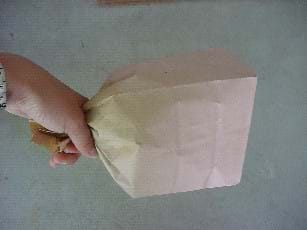
Question: Ask the students, What is in the bag now? (Answer: Air)
Part B — Push a deflated balloon into a canteen and stretch the open end of the airship back over the bottle's mouth (see Effigy ii).
Question: Have the students approximate what will happen to the balloon if you were to effort to inflate it within the bottle. Will the balloon break the bottle, popular or do nothing?
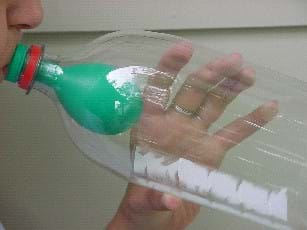
Attempt to blow upwardly the balloon!
Later on the experiment, discuss why the balloon did null. (Answer: Considering air takes up infinite, the bottle was full of air. When you effort to blow upwardly the balloon, the air trapped inside the canteen prevents the balloon from inflating.)
Make the betoken that even though air is invisible, it withal takes up space. Too, discus how engineers need to know how much space air takes upwardly so they tin design filtration systems that are large enough to care for the polluted air created by cars, power plants and factories.
Demo 2 – Air Has Mass
Agree up two inflated balloons of the same size attached to opposite ends of a meter stick. Ask the students if in that location is anything in them. (Respond: Air)
Residue the meter stick such that information technology is perfectly horizontal, showing that both sides accept equal mass (see Effigy 3). This may not exist perfectly accurate, but it is close enough for the demonstration. Ask students to describe why it balances like this.
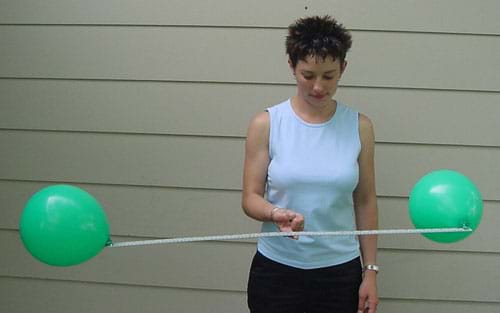
Question: Ask students what will happen if you popular one of the balloons. (Answer: They should predict that the cease with the inflated balloon notwithstanding attached will "become down" and the finish with the deflated balloon will rise. They can commonly relate this to the action of a playground see-saw.)
Pop one of the balloons with the pivot.
Question: Inquire students to describe what happened and why. (Answer: The side of the stick with the popped balloon rises, because the mass of air in that balloon was released, making that side of the stick lighter.)
Make the point that that even though air is invisible, it still has mass. Why is this important for engineers to written report? (Answer: Engineers need to brand sure the filtration systems they blueprint are made from materials stiff plenty to hold the air that is being treated and not break nether the weight of the polluted air.)
Alternatively, use a triple-beam or electronic balance, to measure the mass of the balloon before and after it is inflated. What is the mass of the air within?
Demo 3 – Air Can Move (We Can Feel It)
Talk most air. Tin the students encounter air? How do they know it is there? (Respond: We tin can feel it moving, for case, the wind.)
Direct an electric fan towards the students and turn it on (see Figure four).
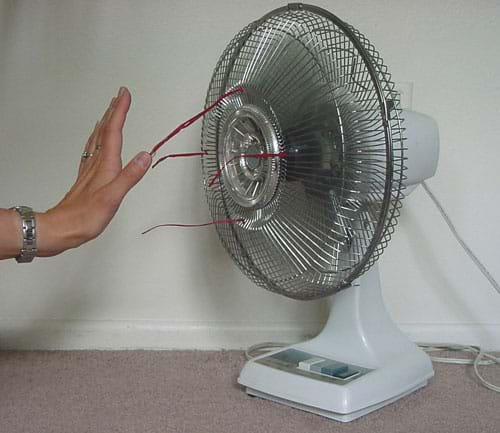
Ask the students what they felt when they were in forepart of the fan.
After their responses, explicate that what they were feeling was air moving very fast. Explain how the fan makes air move very fast.
Make the point that fifty-fifty though air is invisible, it still can move.
Question: Ask the students to give other examples of when air is moving very fast. Why is it of import for engineers to study moving air? (Answer: Engineers demand to know how to motility air through the filtration systems. A very good filtration system is useless if you cannot get the polluted air to go through it.)
Demo four – Air Exerts Pressure (Information technology Pushes on Things)
Part A — Take the students to a identify where in that location is enough of room to run. If it is a nice twenty-four hours, the activity tin be done outside on a playground or in a field. If non, use a gymnasium. At the action area, pick a few volunteer students. Mitt each a piece of 8.five" x 11" paper.
Enquire the residual of the course what they think will happen to a piece of newspaper if the volunteer puts it against their stomach while walking forward without property the paper in place.
Instruct one of the volunteer students to agree a piece of newspaper against their stomach. Have the student allow become of the paper when they begin to walk frontward (see Figure 5). (The paper should fall to the ground.)
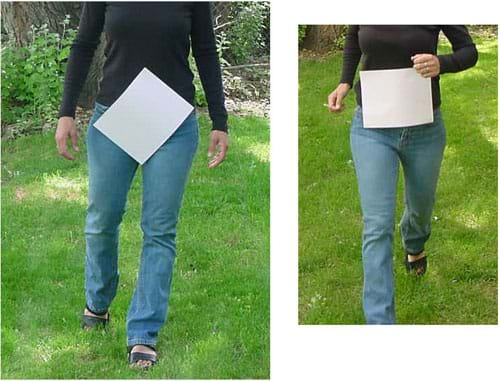
Question: Ask the form if they have any ideas why the paper did not stay against the student's torso.
Question: Ask the students what they call back will happen to the piece of paper if they put it against their stomach and run in a straight line without holding the newspaper in identify.
Select a second volunteer. Have the student place the paper against their stomach and agree information technology with their hand.
Tell the student to brainstorm running in a straight line and let become of the newspaper when they brainstorm running (run across Figure 5). (The paper should stay in place.)
Question: Ask the class if they know why the paper stayed in place when the educatee ran. What acquired the paper to stay in place?
Accept the rest of the students who want to try information technology, practise so.
Afterward, explain that the force holding the newspaper in place when the pupil ran was air. Make the bespeak that even though air is invisible, it exerts pressure. When y'all run, the air pushes against y'all, working to concur the piece of paper confronting your body. While walking, the paper did non stay in place considering the air was not pushing very hard against your body.
Part B — Pass out straws to the students, along with small cups of h2o.
Permit the students to experiment with the straws by roofing the tops with their fingers while withdrawing them from the water. They should note that the water does not fall out of the straws unless they remove their fingers.
Explain to the students that the water does not autumn out when the meridian of the straw is sealed because the pressure of the air outside the harbinger pushes confronting the h2o through the open stop of the straw. (If the h2o were to fall out of a covered straw, a vacuum would be created in the region vacated past the h2o. Since the vacuum has no pressure while the atmosphere does, the force per unit area differential keeps the h2o in the straw against the force of gravity.)
Role C — Question: Ask the students if they think the same result (equally Demo 4B) would occur if instead of a straw, they used a container with a larger diameter.
Fill a jar completely with water. Embrace the mouth of the jar with an index card. Be sure to go the rim of the jar slightly wet. The all-time fashion to practise this is to take a slight excess of water on top earlier you put the carte du jour on.
Keeping one finger on the embrace, invert the container. Carefully remove your finger. Slowly rotate the jar through a consummate circle then the oral cavity faces upwardly and then downwardly again (see Effigy 6). The card should stay on the jar regardless of orientation, showing that air pressure is exerted on the card from the tiptop, lesser and sides.
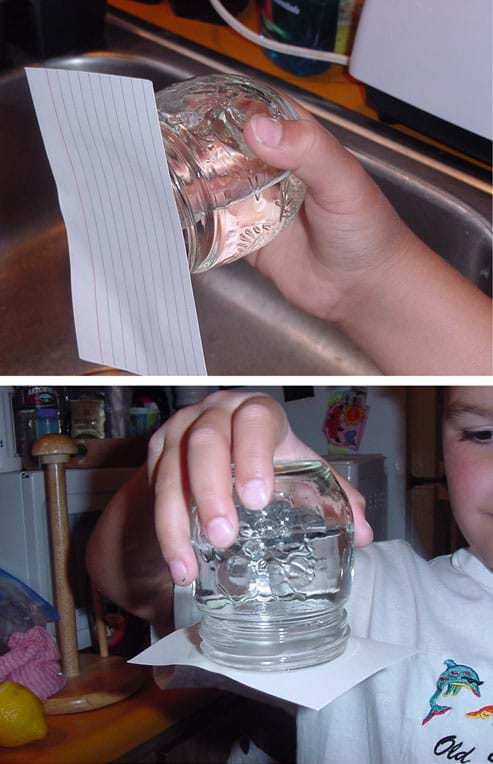
Part D — Crumple a tissue and push button it downwards into the bottom of a glass so that it does not fall out when yous invert the glass.
Plough the glass upside downwardly and place it under the h2o in a bowl (come across Figure vii). Practise non tilt the glass. You lot should detect that the h2o does non enter the drinking glass and that the tissue stays dry.
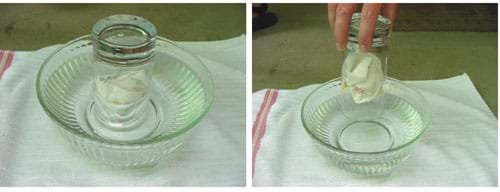
Question: Ask students to suggest ideas for why the tissue does not get wet. (Reply: Water cannot go into the glass [provided you do not tip it] because the drinking glass is full of air.)
Question: Why is this of import to engineers? (Answer: Engineers need to determine how much pressure air exerts so they tin design filtration systems that are large enough for all the air to catamenia through without exerting then much pressure that it breaks the system. Just similar when you were running, the air pushed a slice of paper upwardly against yous. This aforementioned type of pressure is felt by all of the parts of the filtration system as the air moves apace past. Therefore all of the pieces of the arrangement must exist strong plenty to not suspension under this pressure.)
Demo 5 – Air Does Piece of work
Question: Inquire students if they tin suggest a way to lift a pile of books using simply their breath.
Question: If the air is stiff enough to push a piece of paper and hold water in a straw or jar, is it strong enough to move and concur books?
Place a plastic pocketbook under the textbooks such that the open stop is sticking out slightly. Advisedly blow air into the bag, beingness sure to close the end each fourth dimension you put in a new breath. The air in the bag should elevator the books (meet Effigy eight).

Question: Ask the students to depict is happening. (Answer: The air in the bag lifts the books.)
Brand the point that fifty-fifty though air is invisible, it notwithstanding tin exercise work.
Question: Enquire the students to brainstorm other examples of when air does work. (for instance, supporting airplanes, floating hot air balloons, moving windmills, inflating tires that back up cars and bicycles, etc.).
At the terminate, instruct the students to complete the Air – Is It Really In that location? Worksheet.
Assessment
Pre-Activity Assessment
Discussion Question: Inquire a discussion question to get students to recollect well-nigh the upcoming activeness concepts. Record their answers on the lath.
- What are the properties of air? How would you depict air? (Tell them that they will acquire more nigh the properties of air in this activity.)
Activity Embedded Assessment
Question/Answer: During the course of the activity demos, have students answer a series of questions. These are labeled "Question:" throughout the Process section.
Worksheet: During the course of the activity demos, take the students record their observations of the demos on their copy of the Air - Is It Really At that place? Worksheet.
Post-Activity Assessment
Writing: Take the students write a summary virtually the properties of air demonstrated in this action. They should include at to the lowest degree one example (either from the activity or discussion) of each of the properties discussed (air takes up infinite, has mass, moves, exerts pressure, does work). They should also explain why information technology is important for engineers to study the concrete properties of air.
Safety Bug
- Brand sure students remain seated during all demonstrations. Many of the demos utilize drinking glass and so actress care is required to ensure it does not accidentally become cleaved by wandering hands.
Troubleshooting Tips
The demonstrations go more smoothly if you practise them in accelerate.
Be prepared with paper towels or rags for make clean up.
Action Scaling
- Younger students savour these demonstrations. Ask them to draw pictures to show each of the properties of air (air takes upwards infinite, has mass, moves, exerts force per unit area, does piece of work).
References
Cunningham, J. and N. Herr. Hands-on Physics Activities with Real-Life Applications. West Nyack, NY: The Eye for Applied Research in Instruction, pp. 188-210. 1994.
Environmental Science Lesson Plans. Last updated May 15, 2006. Lesson Plans for Teachers, TCEQ, Texas Committee on Environmental Quality. Accessed September 18, 2006. Formerly bachelor from http://world wide web.tceq.country.tx.us/assist/education/grand-12education/lessonplans.html
EPA NE: Indoor Air Quality – Tools for Schools. April 16, 2004. U.Southward. Environmental Protection Agency. Accessed October 13, 2004. http://world wide web.epa.gov/iaq/states/nebraska.html
Walpole, Brenda. 175 Scientific discipline Experiments to Amuse and Amaze Your Friends. Random House, 1988.
Copyright
© 2004 by Regents of the University of Colorado.Contributors
Amy Kolenbrander; Daria Kotys-Schwartz; Janet Yowell; Natalie Mach; Malinda Schaefer Zarske; Denise CarlsonSupporting Programme
Integrated Didactics and Learning Plan, College of Engineering, University of Colorado BoulderAcknowledgements
The contents of this digital library curriculum were developed under a grant from the Fund for the Improvement of Postsecondary Education (FIPSE), U.Southward. Department of Education and National Science Foundation GK-12 grant no. 0338326. All the same, these contents do not necessarily represent the policies of the Department of Educational activity or National Science Foundation, and you lot should not assume endorsement by the federal government.
Concluding modified: April 26, 2022
Source: https://www.teachengineering.org/activities/view/cub_air_lesson01_activity2
0 Response to "Size of Problem Activities Smell a Flower Clip Art"
Post a Comment